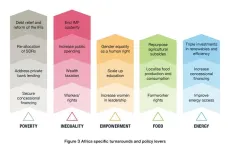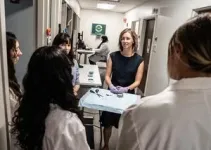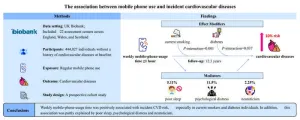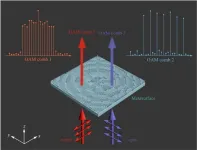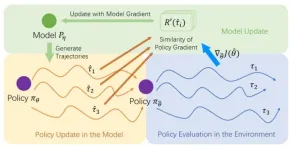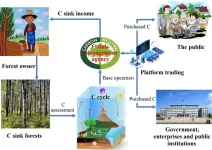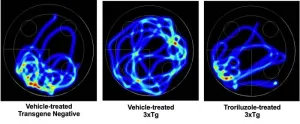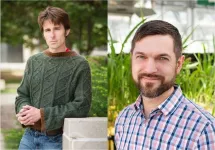How Sub-Saharan Africa can achieve the SDGs by 2100: A new report by Earth4All
In advance of the UN Summit of the Future, Earth4All has released a new report detailing two possible futures for Sub-Saharan Africa this century.
2024-09-04
(Press-News.org) In the best-case scenario, called the "Giant Leap," Sub-Saharan Africa could see poverty drop from 500 million to 25 million people, hunger nearly eradicated, and universal access to education, clean water, and sustainable electricity. On the other hand, the "Too Little Too Late" scenario paints a grim picture where poverty rises to 900 million, hunger still affects 180 million, and over a billion people lack clean water. The Too Little Too Late scenario is based on existing policies in the region. These two scenarios highlight the critical importance of action this decade to drive five extraordinary turnarounds in the areas of poverty, inequality, empowerment, food, and energy.
Key highlights from the modelling for Sub-Saharan Africa include:
Poverty reduction: Under the Giant Leap scenario, poverty decreases dramatically from 500 million to 25 million people by 2100, compared to a rise to 900 million under the Too Little Too Late scenario.
Hunger Eradication: Hunger is nearly eradicated in the Giant Leap, with undernourishment dropping to 20 million, in stark contrast to 180 million under the Too Little Too Late scenario.
Education Access: The average schooling years increase to 13, up from 8 years under the Too Little Too Late scenario.
Water Access: Universal water access is achieved by 2070, significantly improving from over one billion without access in the Too Little Too Late scenario.
Electricity Access: Sustainable electricity access reaches over 95% by 2050, compared to 75% still lacking access under the Too Little Too Late scenario.
Climate Mitigation: Carbon emissions are reach acceptable levels by 2040 as opposed to dangerous levels that push global temperatures even higher.
Economic Growth: Decent work and economic growth see significant boosts, with unemployment falling to 50 million by 2100, compared to 150 million in the Too Little Too Late scenario. Workers' disposable income and GDP per capita also see substantial increases, doubling in comparison to the Too Little Too Late scenario. And inequality is greatly reduced with labour’s share of GDP reaching 60% by 2040, thereby making Africa one of the most equal regions in the world
The new research from Earth4All, an international team of economists and scientists, shows the policy levers needed to ensure that the SDGs are met in Sub-Saharan Africa by 2100. The report ‘SDGs for All: Africa’ equips policymakers with practical solutions designed to accelerate SDG implementation and to respond to the planetary emergency. It concludes that policymakers can step up the implementation of the SDGs by 2030 and beyond and achieve wellbeing for all. But this is only possible by enacting five ‘extraordinary turnarounds’ that break with current trends.
“The challenge for Sub-Saharan Africa this century is that economic transformation must now take place in the shadow of a climate emergency. This is a breakthrough or breakdown moment for the continent. It teeters on the brink of two vastly different futures: one of transformative progress and one of deepening despair. As we approach the UN Summit of the Future this September, the time for bold, decisive action is now—to ensure a 'Giant Leap' towards a future where poverty and hunger are eradicated, and every individual has access to education, clean water, and sustainable energy. Our choices today will shape the destiny of millions. We must act, and we must act decisively.” Said Jane Kabubo-Mariara, Executive Director of the Partnership for Economic Policy and member of the Earth4All Transformational Economics Commission.
"The UN Summit of the Future is the next port of call to leverage the global support for action on the SDG's and ensure governments and the Bretton Woods institutions heighten the ambition needed on eradicating poverty and inequality within the planetary boundaries. This summit presents a crucial opportunity for world leaders to commit to the transformative solutions and partnerships needed.” said Sandrine Dixson-Declève, co-president of The Club of Rome and Executive Chair of Earth4All. “Our findings demonstrate that systemic change, focusing on reducing inequality and poverty, is not just beneficial but necessary for sustainable development and climate resilience in Africa and the rest of the world.”
The report, supported by the UN University Centre for Policy Research (UNU-CPR) and the UN Futures Lab, serves as a critical resource ahead of the upcoming Summit of the Future, urging global leaders, policymakers, and stakeholders to act decisively. It builds on Earth4All’s system dynamics modelling of the SDGs, which culminated in a global report published last year: SDGs for All.
END
ELSE PRESS RELEASES FROM THIS DATE:
2024-09-04
Philadelphia, September 4, 2024 – A new study has found that regular mobile phone use was positively associated with incident cardiovascular diseases risk, especially in current smokers and individuals with diabetes. In addition, this association was partly attributed to poor sleep, psychological distress, and neuroticism. The article in the Canadian Journal of Cardiology, published by Elsevier, details the results of this large-scale prospective cohort study.
Yanjun Zhang, MD, Division of Nephrology, Nanfang Hospital, Southern Medical University, Guangzhou, China, explains, "Mobile phone use is a ubiquitous exposure in modern society, so exploring its impact on health has ...
2024-09-04
COLUMBUS, Ohio – About half of adults can identify cigarettes and e-cigarettes, but just one in four would recognize oral nicotine pouches, and these easily available products are growing increasingly popular among teens and young adults, according to a recent study commissioned by The Ohio State University Comprehensive Cancer Center – Arthur G. James Hospital and Richard J. Solove Research Institute (OSUCCC – James).
Oral nicotine pouches are small packets filled with a flavored powder containing nicotine and other chemicals that are tucked between the lip and gums. ...
2024-09-04
Introduction
As a new degree of freedom, the orbital angular momentum of electromagnetic waves exceeds the traditional frequency, phase, and amplitude, and is expected to promote the infinite expansion of channel capacity. Recently, a team of research professor Chao-Hai Du from Peking University and Professor Xiaofei Zang's research group from the University of Shanghai for Science and Technology have carried out in-depth cooperation. Based on the research foundation of both sides in the field of terahertz and metasurface, a new method of generating polarization-multiplexed terahertz vortex combs using all-silicon metasurface has been ...
2024-09-04
Recently, model-based reinforcement learning has been considered a crucial approach to applying reinforcement learning in the physical world, primarily due to its efficient utilization of samples. However, the supervised learned model, which generates rollouts for policy optimization, leads to compounding errors and hinders policy performance. To address this problem, the research team led by Yang YU published their new research on 15 August 2024 in Frontiers of Computer Science co-published by Higher Education ...
2024-09-04
Since the first industrial revolution, the rapid development of the human economy and society has directly exacerbated the process of CO2 emission from human activities such as fossil fuel combustion, industrial processes, agriculture, and land use activities. With the continuous increase of global greenhouse gas concentration dominated by CO2, the greenhouse effect is becoming more and more obvious, and the trend of global warming is becoming more and more serious. To cope with the continuous warming of the global climate and mitigate ...
2024-09-04
Combine cyberbullying, smartphone use, lack of sleep and poor mental health, and you have the perfect storm for a teenage meltdown.
Australian researchers have polled more than 50,000 primary and secondary school students aged 7-19 years about the link between their sleep and nighttime phone habits, experience of cyberbullying and stress levels.
Researchers from the Behaviour-Brain-Body Research Centre at the University of South Australia found that across all genders and age groups, phone use overnight not only robbed children of sleep, but it also had a negative impact on their mental health, ...
2024-09-04
AUBURN, AL — In a recent development in Alzheimer's disease research, Auburn University scientists have studied a new drug, troriluzole, that can prevent brain changes leading to memory loss and cognitive decline in a mouse model of the disease. This study, recently published in the Journal of Neurochemistry, is the first to show how troriluzole can target early-stage alterations associated with Alzheimer’s, providing new hope for potential treatments.
Dr. Miranda Reed, a Professor in the department ...
2024-09-04
Pennington Biomedical Research Center’s Dr. Jeff Keller is evaluating the potential for delta-9-tetrahydrocannabinol, or THC, and cannabidiol, or CBD, to reduce the behaviors indicating agitation, distress or anxiety in patients with Alzheimer’s disease or other forms of dementia. The study is designed for hospice-eligible patients who are either receiving hospice care or who are eligible for hospice, and who are exhibiting agitation concurrently with a diagnosis of dementia. There are currently no FDA-approved medications to treat agitation at the end-of-life stages in dementia patients.
The “Life’s End Benefits of Cannabidiol and ...
2024-09-04
URBANA, Ill. — The National Science Foundation (NSF) has funded University of Illinois Urbana-Champaign research that aims to connect the dots between quantitative and molecular genetics and improve crop breeding.
The four-year, $795,000 grant investigates new theories on how genetics influence complex crop traits, such as yield or grain quality. These traits are controlled by lots of different genes — sometimes hundreds or thousands — which makes untangling their contributions difficult. Crop breeders use a host of advanced genetic tools to predict and ...
2024-09-04
Boston – CDK4/6 inhibitors, which are already FDA approved for the treatment of other forms of cancer, show early signs of promise in the treatment of a subtype of pediatric high-grade glioma, according to new research from Dana-Farber Cancer Institute and the Institute of Cancer Research in London. Treatment of a patient with a second relapse of this glioma subtype and no other treatment options resulted in 18 months of progression-free survival.
“We are finally starting to see more targeted therapies come out for different forms of brain cancer,” says senior author Mariella Filbin, MD, PhD, co-director ...
LAST 30 PRESS RELEASES:
[Press-News.org] How Sub-Saharan Africa can achieve the SDGs by 2100: A new report by Earth4All
In advance of the UN Summit of the Future, Earth4All has released a new report detailing two possible futures for Sub-Saharan Africa this century.
